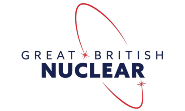
Radioactive waste is a type of hazardous waste that contains radioactive material. Radioactive waste is a result of many activities, including nuclear medicine, nuclear research, nuclear power generation, nuclear decommissioning, rare-earth mining, and nuclear weapons reprocessing. The storage and disposal of radioactive waste is regulated by government agencies in order to protect human health and the environment.

Sellafield, formerly known as Windscale, is a large multi-function nuclear site close to Seascale on the coast of Cumbria, England. As of August 2022, primary activities are nuclear waste processing and storage and nuclear decommissioning. Former activities included nuclear power generation from 1956 to 2003, and nuclear fuel reprocessing from 1952 to 2022.

Magnox is a type of nuclear power / production reactor that was designed to run on natural uranium with graphite as the moderator and carbon dioxide gas as the heat exchange coolant. It belongs to the wider class of gas-cooled reactors. The name comes from the magnesium-aluminium alloy, used to clad the fuel rods inside the reactor. Like most other "Generation I nuclear reactors", the Magnox was designed with the dual purpose of producing electrical power and plutonium-239 for the nascent nuclear weapons programme in Britain. The name refers specifically to the United Kingdom design but is sometimes used generically to refer to any similar reactor.

Great British Nuclear (GBN), formerly British Nuclear Fuels Ltd (BNFL), is a nuclear energy and fuels company owned by the UK Government. It is a non-departmental public body sponsored by the Department for Energy Security and Net Zero.

Low-level waste (LLW) or low-level radioactive waste (LLRW) is nuclear waste that does not fit into the categorical definitions for intermediate-level waste (ILW), high-level waste (HLW), spent nuclear fuel (SNF), transuranic waste (TRU), or certain byproduct materials known as 11e(2) wastes, such as uranium mill tailings. In essence, it is a definition by exclusion, and LLW is that category of radioactive wastes that do not fit into the other categories. If LLW is mixed with hazardous wastes as classified by RCRA, then it has a special status as mixed low-level waste (MLLW) and must satisfy treatment, storage, and disposal regulations both as LLW and as hazardous waste. While the bulk of LLW is not highly radioactive, the definition of LLW does not include references to its activity, and some LLW may be quite radioactive, as in the case of radioactive sources used in industry and medicine.

Dounreay is a small settlement and the site of two large nuclear establishments on the north coast of Caithness in the Highland area of Scotland. It is on the A836 road nine miles west of Thurso.

Chapelcross nuclear power station is a former Magnox nuclear power station undergoing decommissioning. It is located in Annan in Dumfries and Galloway in southwest Scotland, and was in operation from 1959 to 2004. It was the sister plant to the Calder Hall nuclear power station plant in Cumbria, England; both were commissioned and originally operated by the United Kingdom Atomic Energy Authority. The primary purpose of both plants was to produce weapons-grade plutonium for the UK's nuclear weapons programme, but they also generated electrical power for the National Grid. Later in the reactors' lifecycle, as the UK slowed the development of the nuclear deterrent as the cold war came to a close, power production became the primary goal of reactor operation.

The Nuclear Decommissioning Authority (NDA) is a non-departmental public body of the Department for Energy Security and Net Zero formed by the Energy Act 2004. It evolved from the Coal and Nuclear Liabilities Unit of the Department of Trade and Industry. It came into existence during late 2004, and took on its main functions on 1 April 2005. Its purpose is to deliver the decommissioning and clean-up of the UK's civil nuclear legacy in a safe and cost-effective manner, and where possible to accelerate programmes of work that reduce hazard.
Sellafield Ltd is a British nuclear decommissioning Site Licence Company (SLC) controlled by the Nuclear Decommissioning Authority (NDA), a UK government body set up specifically to deal with the nuclear legacy under the Energy Act 2004. From 2008–2016, it was operated under licence from the NDA by a third party Parent Body Organisation called Nuclear Management Partners (NMP). Since the termination of the NMP contract it has been brought back under direct governmental control by making it a subsidiary of the NDA.

The Nuclear Waste Policy Act of 1982 is a United States federal law which established a comprehensive national program for the safe, permanent disposal of highly radioactive wastes.
Saltcrete is a mixture of cement with salts and brine, usually originating from liquid waste treatment plants. Its role is to immobilize hazardous waste and in some cases lower-level radioactive waste in the form of solid material. It is a form of mixed waste.

The Magnox Reprocessing Plant is a former nuclear reprocessing facility at Sellafield in northern England, which operated from 1964 to 2022. The plant used PUREX chemistry to extract plutonium and uranium from used nuclear fuel originating primarily from Magnox reactors. The plant was originally constructed and operated by the United Kingdom Atomic Energy Authority (UKAEA), but in 1971 control was transferred to British Nuclear Fuels Limited (BNFL). From 2005 the plant was operated by Sellafield Ltd.

A deep geological repository is a way of storing hazardous or radioactive waste within a stable geologic environment, typically 200–1,000 m below the surface of the earth. It entails a combination of waste form, waste package, engineered seals and geology that is suited to provide a high level of long-term isolation and containment without future maintenance. This is intended to prevent radioactive dangers. A number of mercury, cyanide and arsenic waste repositories are operating worldwide including Canada and Germany. Radioactive waste storage sites are under construction with the Onkalo in Finland being the most advanced.
Nuclear decommissioning is the process leading to the irreversible complete or partial closure of a nuclear facility, usually a nuclear reactor, with the ultimate aim at termination of the operating licence. The process usually runs according to a decommissioning plan, including the whole or partial dismantling and decontamination of the facility, ideally resulting in restoration of the environment up to greenfield status. The decommissioning plan is fulfilled when the approved end state of the facility has been reached.

Scottish Nuclear was formed as a precursor to the privatisation of the electricity supply industry in Scotland on 1 April 1990. A purpose-built headquarters was built in 1992 in the new town of East Kilbride.
Nuclear Electric was a nuclear power generation company in the United Kingdom. It was formed in 1990 as part of the privatisation process of the UK Electricity Supply Industry.
Scientific Ecology Group, Inc. located in Oak Ridge, Tennessee was founded by H.W.(Bud) Arrowsmith in 1985. It quickly grew to become the leading radioactive waste processor in the United States employing 1,400 personnel at its largest. Treatment technologies included supercompaction, incineration, vitrification and metal melt.

High-level radioactive waste management addresses the handling of radioactive materials generated from nuclear power production and nuclear weapons manufacture. Radioactive waste contains both short-lived and long-lived radionuclides, as well as non-radioactive nuclides. In 2002, the United States stored approximately 47,000 tonnes of high-level radioactive waste.

The Clive Disposal Site is the site of a radioactive waste storage facility currently operated by EnergySolutions in Clive, Utah, an unincorporated community of Tooele County. It is located in the western portion of the state, close to the Dugway Proving Grounds. The site accepts depleted uranium, a material that takes millions of years to decay, and therefore requires special precautions and regulations.

Nuclear Restoration Services (NRS) is a British nuclear decommissioning Site Licence Company (SLC) owned by the Nuclear Decommissioning Authority (NDA).















